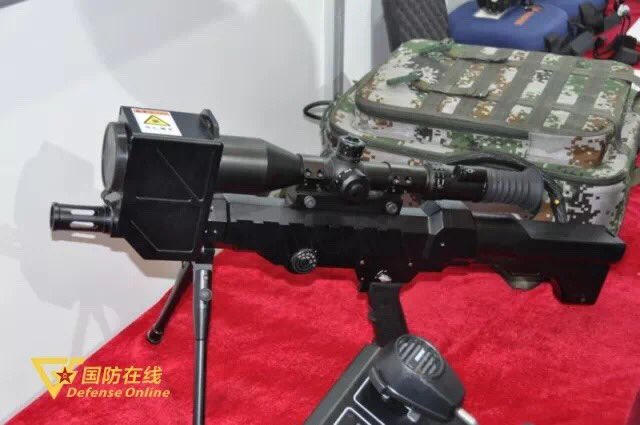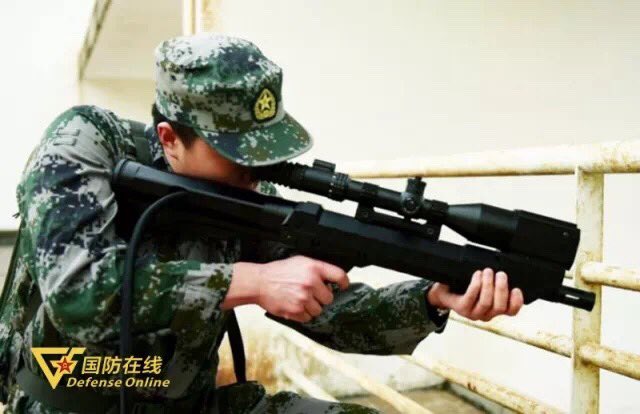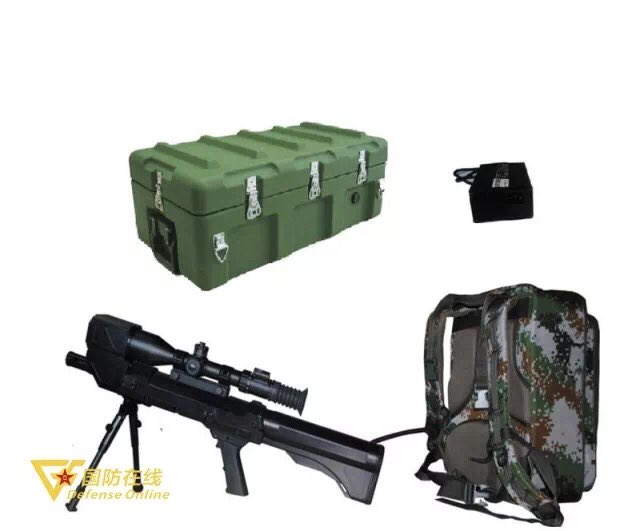You are using an out of date browser. It may not display this or other websites correctly.
You should upgrade or use an alternative browser.
You should upgrade or use an alternative browser.
chinese laser weapon development
- Thread starter maozedong
- Start date
Hendrik_2000
Lieutenant General
Well the manufacturer release the video because a lot of people are skeptical about the existence of true laser weapon like this article
Thankfully, a future in which Chinese troops are carrying “laser assault rifles” that can realistically burn through targets, human or otherwise, from a half a mile away still seems to be a ways away.
Thankfully, a future in which Chinese troops are carrying “laser assault rifles” that can realistically burn through targets, human or otherwise, from a half a mile away still seems to be a ways away.
If the tech is there for a man portable laser to seriously burn a person or make holes in surfaces without armor from 100-200 m away, why not rather utilize that tech for a 500 kg laser on a vehicle, to kill a person from 300-500 m away? Or does it not scale that way? With computer aided target tracking and no probability of miss, fire from a stable platform such as a vehicle could virtually guarantee a kill every time an enemy soldier is detected, even if for just a few seconds. Even aiming at just the head should be doable, since there is no chance to miss. A battery offering just a few hundred of such shots should be enough, if made modular enough to be replaced within minutes.
If the tech is there for a man portable laser to seriously burn a person or make holes in surfaces without armor from 100-200 m away, why not rather utilize that tech for a 500 kg laser on a vehicle, to kill a person from 300-500 m away? Or does it not scale that way? With computer aided target tracking and no probability of miss, fire from a stable platform such as a vehicle could virtually guarantee a kill every time an enemy soldier is detected, even if for just a few seconds. Even aiming at just the head should be doable, since there is no chance to miss. A battery offering just a few hundred of such shots should be enough, if made modular enough to be replaced within minutes.
I guess it is not as "stealthy" to use a vehicle-bound version.
Hendrik_2000
Lieutenant General
Here is the photos from the above link From henri K blog
The "Defender" individual laser weapon, designed to target mainly optronic equipment, communication wiring, radar and tanks.




The "Defender" individual laser weapon, designed to target mainly optronic equipment, communication wiring, radar and tanks.




So i tried to dig out some data on what factors limit laser efficiency. And one of the big ones is aperture size. Its growth is basically linear with decrease in beam divergence, which is crucial if one is to have enough power remaining on target after the beam has crossed a certain distance. Commercial lasers today usually have divergence of 0.1 to 1 mrad. Military lasers that seek to damage stuff at distance usually can get down to 0.01 or less, with the best ever result that i could find, YAL-1 airborne laser with divergence of just 0.001 mrad.
So what happens if one has a 100 kw beam output (requiring some 250 kw input by today best (though out of laboratory) standard), 0.01 mrad divergence and reaches for a target that is 500 m away? Beam will be 5% wider at that distance and the wattage hitting the target will be 11.5 watts per mm squared. One kilowatt of energy at point blank distance can burn through some 1-2mm of wood per one tenth of a second. So I'd say those 11.5 watts might be enough for some sort of a burn, if skin is exposed, but not much more. Feel free to correct me, though.
Today DARPA is working on a 150 kw output laser weapon weighing 1650 pounds or 750 kg, few cubic meters in volume. So lets say soon enough such 100 kw output laser from my example may weigh 500 kg, give or take. That's a weight and size that's inappropriate for Humvee class vehicle but may be appropriate for various wheeled APC vehicles and larger vehicles.
But still, at 500 m away, the power delivered to target is fairly low. It could heat stuff up, of course, and certainly damage components. Or even suppress the enemy from exposing themselves for more than a second or two. And it is using a fairly large aperture, to tie back into the beginning of my post. I used a 10 cm aperture, which is pretty big, in line with most of the vehicle mounted systems in dvelopment today. If somehow the aperture dropped to 1 cm, for a smaller gun, something an individual soldier could carry around and still retain a practical weapon, power delivered to the target would drop to just 1.1 watts per mm2 at same distance.
Equally so, if one managed to mount a huge system, with 1 meter aperture on that vehicle, power to target at same distance would increase to 115 watts per mm2. Which could cause serious injuries in just a few tenths of a second, if skin is exposed. (again, correct me here please). Issue, of course, is that not only would that add weight, but it'd be less practical, harder to maintain and clean and would simply make the vehicle and the whole system much more visible and easier to damage. Imagine a 2 meter high vehicle with an additional optics 1 m in diameter on top of it. That wouldn't really fly. YAL-1 laser did have 1 meter aperture, as it could afford the room, but it is impossible to expect such apertures from most combat lasers, be it on tactical vehicles or tactical aircraft. Perhaps some dedicated AD systems on large trucks could afford such apertures, or ship based lasers could. But that's it.
So what happens if one has a 100 kw beam output (requiring some 250 kw input by today best (though out of laboratory) standard), 0.01 mrad divergence and reaches for a target that is 500 m away? Beam will be 5% wider at that distance and the wattage hitting the target will be 11.5 watts per mm squared. One kilowatt of energy at point blank distance can burn through some 1-2mm of wood per one tenth of a second. So I'd say those 11.5 watts might be enough for some sort of a burn, if skin is exposed, but not much more. Feel free to correct me, though.
Today DARPA is working on a 150 kw output laser weapon weighing 1650 pounds or 750 kg, few cubic meters in volume. So lets say soon enough such 100 kw output laser from my example may weigh 500 kg, give or take. That's a weight and size that's inappropriate for Humvee class vehicle but may be appropriate for various wheeled APC vehicles and larger vehicles.
But still, at 500 m away, the power delivered to target is fairly low. It could heat stuff up, of course, and certainly damage components. Or even suppress the enemy from exposing themselves for more than a second or two. And it is using a fairly large aperture, to tie back into the beginning of my post. I used a 10 cm aperture, which is pretty big, in line with most of the vehicle mounted systems in dvelopment today. If somehow the aperture dropped to 1 cm, for a smaller gun, something an individual soldier could carry around and still retain a practical weapon, power delivered to the target would drop to just 1.1 watts per mm2 at same distance.
Equally so, if one managed to mount a huge system, with 1 meter aperture on that vehicle, power to target at same distance would increase to 115 watts per mm2. Which could cause serious injuries in just a few tenths of a second, if skin is exposed. (again, correct me here please). Issue, of course, is that not only would that add weight, but it'd be less practical, harder to maintain and clean and would simply make the vehicle and the whole system much more visible and easier to damage. Imagine a 2 meter high vehicle with an additional optics 1 m in diameter on top of it. That wouldn't really fly. YAL-1 laser did have 1 meter aperture, as it could afford the room, but it is impossible to expect such apertures from most combat lasers, be it on tactical vehicles or tactical aircraft. Perhaps some dedicated AD systems on large trucks could afford such apertures, or ship based lasers could. But that's it.
D
Deleted member 13312
Guest
Before that can be ever achieved, we did be seeing tank gun's being replaced with lasers. cannons This is one of those ridiculous bandwagon, flavour of the month esque things. The USAF starts some highly doubtful claims of slapping on lasers on the F-35, and then all of a sudden everyone and their family dog starts thinking that that's a feasible idea.The powerplants are still too massive. Not sure how much of it is diesel / gasoline generators; though, if the power unit can be made compact enough, you can slap it on a J-20 pod installed into the short-range missile bay.


